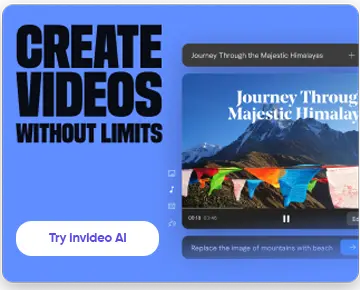A recent study by Nielsen (in collaboration with Google) found that using AI-powered video campaigns can improve sales performance by 23%. That’s a big jump, and it clearly shows how AI isn’t just helpful for automating tasks, but also for making high-performing content.
One ad format that’s becoming more popular is AI UGC ads. These videos look like real people talking about a product, but they’re actually created with AI. Brands are using them to make faster, cost-effective, and scalable content without needing real users or actors.
So, if you’re looking to use AI for creating UGC ads for better reach and higher conversions, stay till the end of this blog. Here’s what all we have covered ahead:
- What Are AI UGC Ads
- Types of AI UGC Ads
- How AI UGC Ads Work
- Why AI UGC Ads Convert
- How to Create UGC Ads with AI
- Challenges and Risks of AI UGC Ads
Now, let’s get started!
Generate UGC Videos with AI
Pick AI actors, drop in your product link, and launch UGC ads faster than hiring freelancers.
 Generate now
Generate now
What Are AI UGC Ads?
AI UGC ads refer to promotional content generated using artificial intelligence that showcases AI avatars or characters talking about a particular product or service. Sometimes brands also use real actors, but the goal remains the same. It's to make the content feel personal and relatable, just like real customer reviews or testimonials.
What makes these ads different is that everything from script to the visuals is created using AI. This mix is easy to scale content and customize the messages for different audiences while keeping the cost lower than usual UGC. However, since the content is made to mimic real users, it's also important to be transparent about the content.
Types of AI UGC Ads
AI UGC ads may take different forms depending on the platform and, of course, the requirement itself. However, the 4 most important and common types of AI UGC ads include:
Text-Based UGC
These ads use AI-generated written content in the form of comments, reviews or discussions from users of a given product or service. Text-based UGC also includes blog comments, social media threads, or replies on product forums. So, a brand might use AI to create realistic sounding social media comments that appear to share genuine experiences with a product.
This type of content helps create depth in the conversation around the product, especially when the goal is to highlight different use cases or detailed feedback. However, since these texts are not written by real users, it's important to avoid presenting them as authentic views under their clearly disclosed as scripted or simulated.
Images
Some AI UGC ads also use AI-generated images that look just like photos taken by real customers. These images usually show people using the product, before and after results, or even casual lifestyle shots that look like they were captured while using the product.
The goal here is to make the image feel as relatable and authentic as possible, as if the customer took and posted it themselves. But again, it's important to make it clear that the image was generated by AI, especially if it includes AI avatars or photorealistic scenes that didn't actually happen.
Videos
Videos are undoubtedly one of the most popular and common formats of AI UGC ads, especially on platforms like Instagram Reels, TikTok, and YouTube Shorts. These short videos usually feature AI-generated avatars or even real humans talking about a product or service and sharing their experience of using it.

Source: Instagram
For example, this reel made for Swass Montana – a beauty and personal care product is a perfect example of how effective yet informative AI UGC ads can be. It clearly highlights what makes the product stand out, and since it's AI-generated, it's easy to customise it according to the brand voice.
Just like real UGC, these ads are also aimed at keeping the content relatable as well as authentic. AI UGC videos are mostly useful for brands that want to run testimonials at scale in different languages or styles without hiring multiple creators. But if the person in the video isn't real, or if the story is entirely scripted, it's recommended to clearly mention so.
Reviews
Some brands use AI to create product reviews that look like they came from real customers on platforms like Amazon or the app store. These might talk about fast delivery, ease of use, or why the buyer recommends it. AI can write these reviews in different tones, be it enthusiastic, neutral, or even slightly critical, to make it feel more realistic.
However, this often becomes a critical area to deal with because posting AI-generated reviews on real platforms without disclosure can mislead customers and go against platform rules or even legal guidelines. So, if you are using simulated reviews in your ads, be upfront that the review is fictional and only meant for promotional purposes.
How Do AI UGC Ads Work?
Creating AI UGC ads is actually quite simple once you understand how the tools work. The process gets even easier with invideo AI, which lets you control everything from the script to the product details, or the type of audience you're targeting. It offers several features like:
UGC Human Virtual Actors: Clips of real actors across different ages and geographies, such as Australia, Britain, Africa, India, and Asia.
- UGC Virtual Actors: Explore a vast library of generative AI avatars for your UGC ad.
- Script Style: Choose from a wide variety of styles, including – problem solution, before and after, pattern interrupt, social proof, urgency/FOMO, cost saving, objection handling, or aspirational.
- Language: More than 50 languages are available for customization and connecting with a more diverse and global audience.
With invideo AI, you can generate a fully customized UGC ad within minutes without any prior video editing experience. Simply enter your prompt, choose your customization settings, and…that’s it. Let the tool handle the rest of the heavy lifting.
Make UGC Ads in Minutes
Create selfie-style, walk-and-talk UGC videos using invideo AI with just your product link.
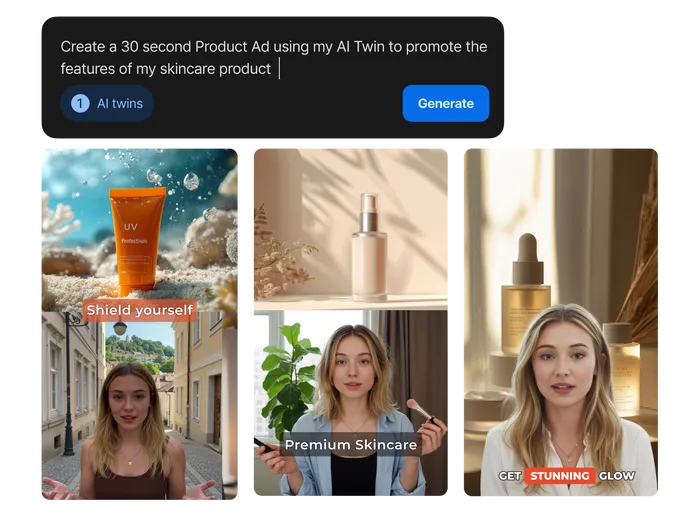 Try now
Try now
Why Do AI UGC Ads Convert?
Okay, here’s something to think about: believing that AI-generated content could actually convince someone to buy a product might seem strange. Doesn’t it? After all, we usually associate conversions with real human connection, and AI doesn't exactly fit that criterion.
But that's exactly where the core strategy behind AI UGC lies. These ads work not because they trick people into thinking they are real, but because they actually borrow that real style, structure, and tone. So, if we look deeper into the reasons, here are the main factors that make it work:
More Room for Personalization
One big reason these ads convert well is that AI makes it easy to personalize content for different groups of people. You can quickly generate different versions of the same ad, tweak the tone, language, or visuals to suit different audiences. Exactly as per the requirement. This customization makes the ad feel more relevant, which naturally leads to better engagement.
Relevance matters more than perfection here. You see, even if the viewer can tell it’s an AI avatar, if the message feels like it’s speaking directly to them and their situation, it would still hold their attention. That small connection often makes a person remember the brand and consider trying the product.
High Volume Production
One of the biggest advantages of AI UGC ads is that they can be quickly and easily produced within minutes. You don't need to hire an actor, book slots, edit the whole footage, and then manually make all the needed changes. With AI, you can simply create one or even multiple ad variations at scale. That's the convenience that traditional methods simply don't bring.
AI UGC ads also make A/B testing much more efficient. You don't have to guess which version might perform better. Simply put all your variations and use the insights to analyse what's working and what's not. Once you know which tone, style, or format gets the audience's best response, you can focus on that. This isn't always possible with human-only content creation.
Reduced Production Costs
Producing high-quality UGC using traditional methods can get expensive quickly as you need to pay for creators, crew, locations, editing, and revisions. Sometimes all of that for a single piece of content.
And that’s before you even run the ad. AI UGC removes all this hassle because all you need is an idea, and the AI can handle the rest. Ultimately, this brings down the production costs and makes it easier to run ongoing campaigns without a massive budget. This way, you can try different styles or formats without wasting money on content that definitely won’t work.
Dealing with Ad Fatigue
Ad fatigue is a real headache. When people see the same type of polished, salesy content over and over again, they simply stop paying attention. AI UGC ads feel more like personal recommendations than hard-selling ads, and this fresh format can catch the viewer’s eye. Why? Because it doesn’t look like a typical ad.
That’s a big win on platforms like Instagram, where users are usually doomscrolling.
What helps even more is that these AI-generated videos can be styled to match the tone and feel of the platform they’re on. So, no matter if you’re making these for TikTok, Instagram Reels, or YouTube Shorts, AI UGC can be made to blend in with creator content. When an ad looks like regular content, viewers are much more likely to engage, which naturally boosts conversion.
Generate Ads with AI Actors
Select AI actors, add your product link, and generate UGC ads fast and easy.
 Generate now
Generate now
How to Create UGC Ads with AI
So, AI UGC ads are an efficient way to produce quality content at scale. But how do you create them on your own? With invideo AI, that’s easier than ever. Here’s a step-by-step guide to help you get started:
- Sign up on invideo AI with your email address and set up a password. If you’re an existing user, log in with your credentials.
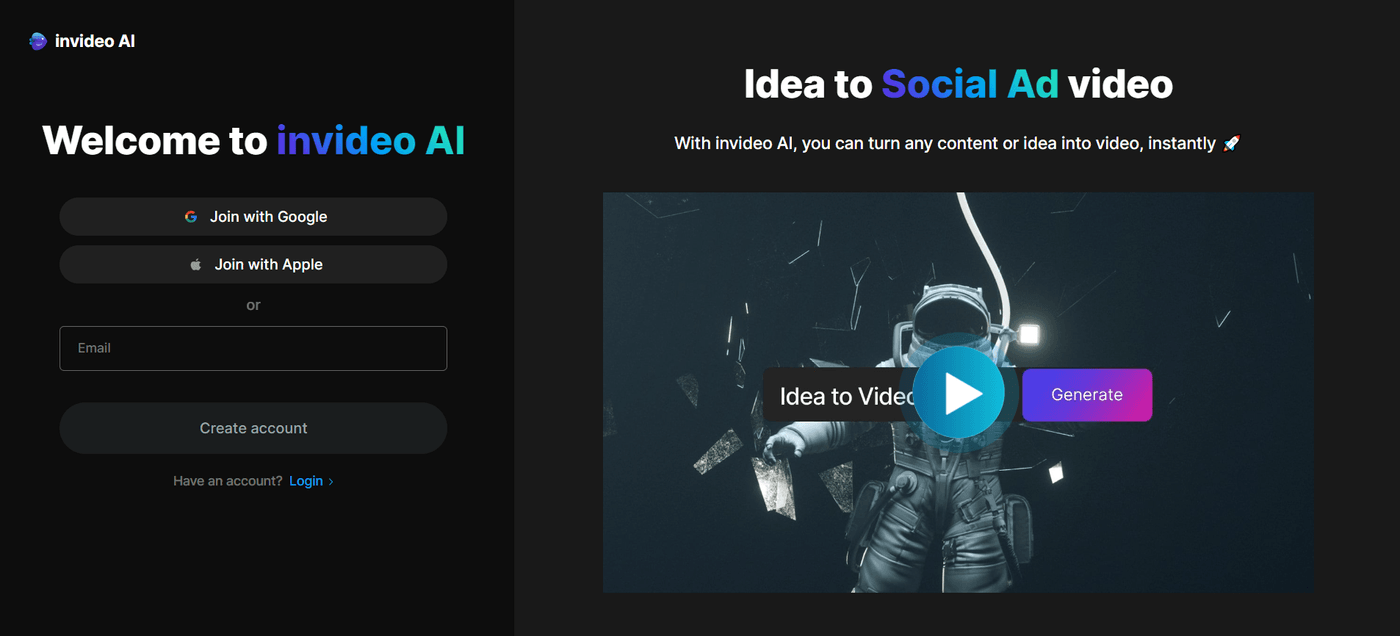
- Now, click on “Create UGC ad” to proceed.
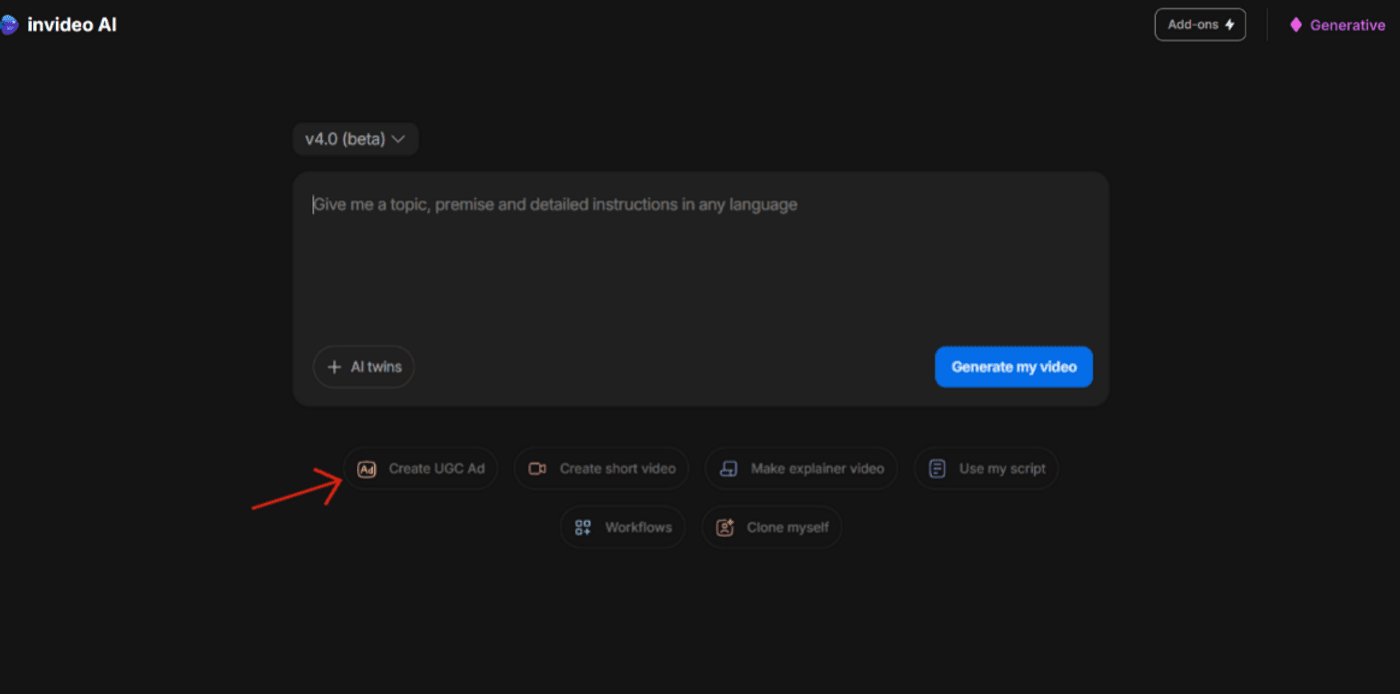
- Go to “Choose Actor” to select an actor for your ad.
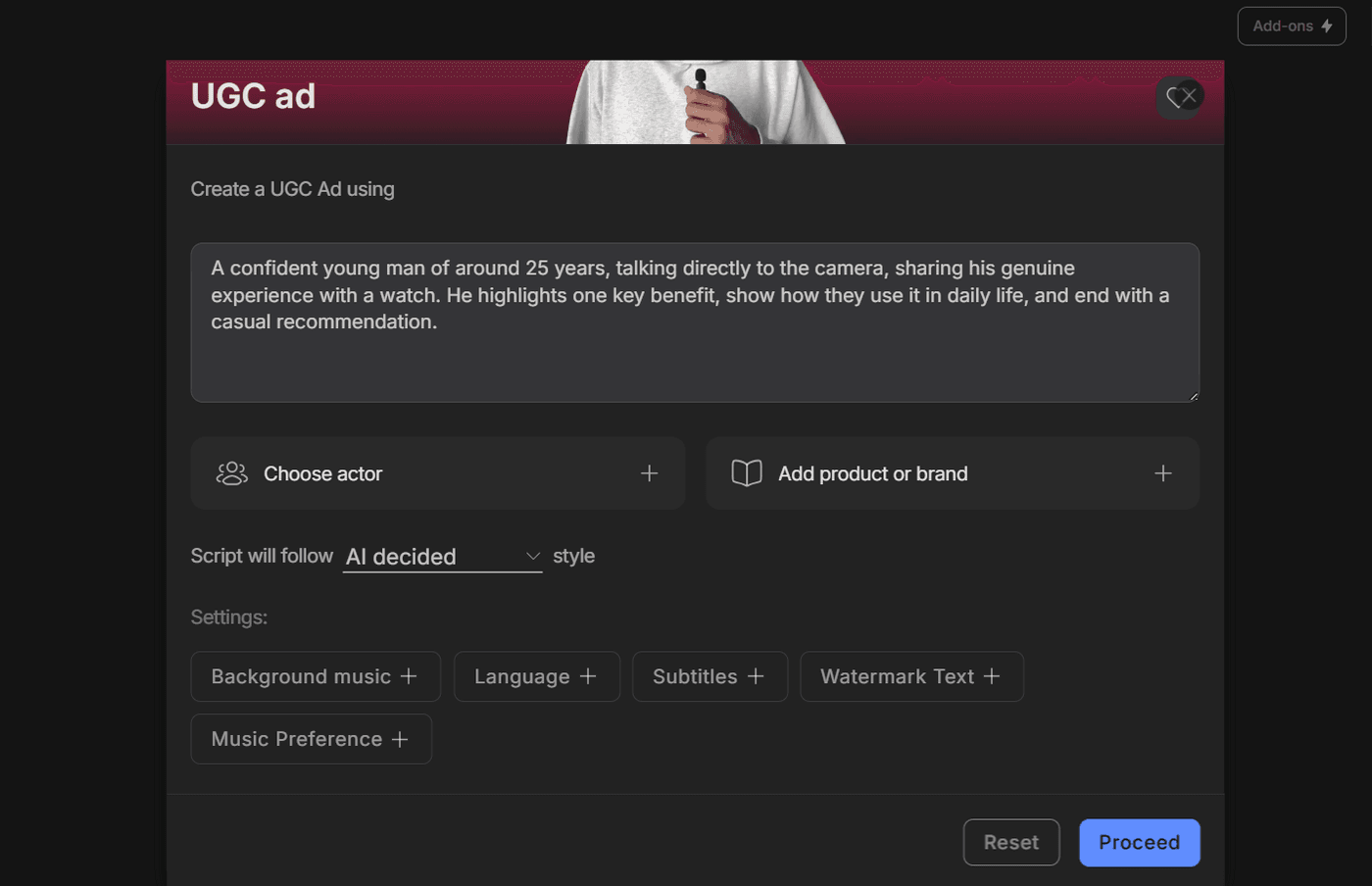
- Choose any actor from the given options that fits your criteria. You can also apply filters like gender, age, location, etc, to find more customized options.

- Now, click on “Select product” to add more details about the product you are creating the ad for.

- The dashboard will now show two options. You can either create it manually or simply paste the product/ brand link in the space provided.
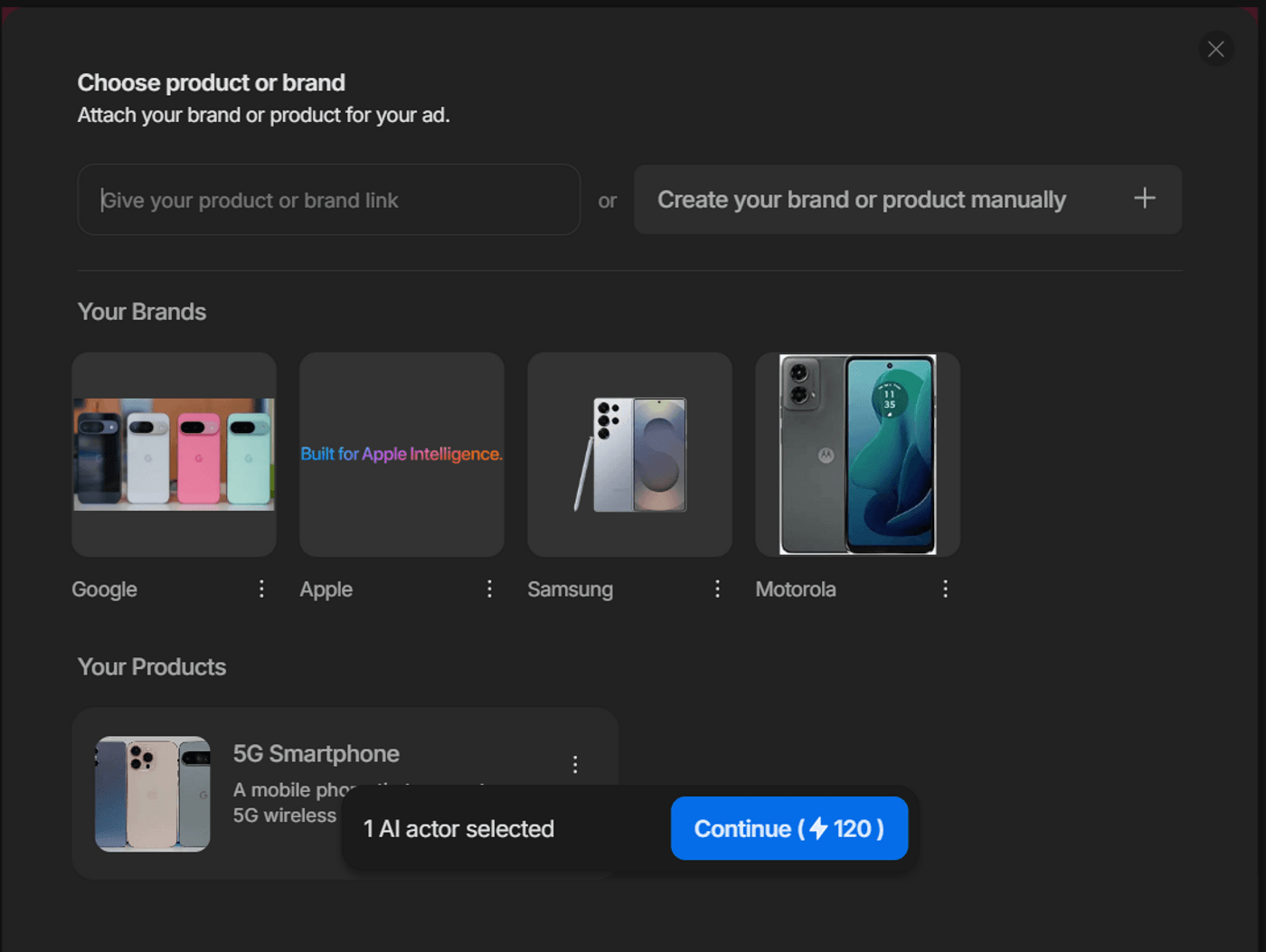
- Now, go back and customise the settings for language, watermark, background music, subtitles, and audio. Once done, click on “Proceed.”
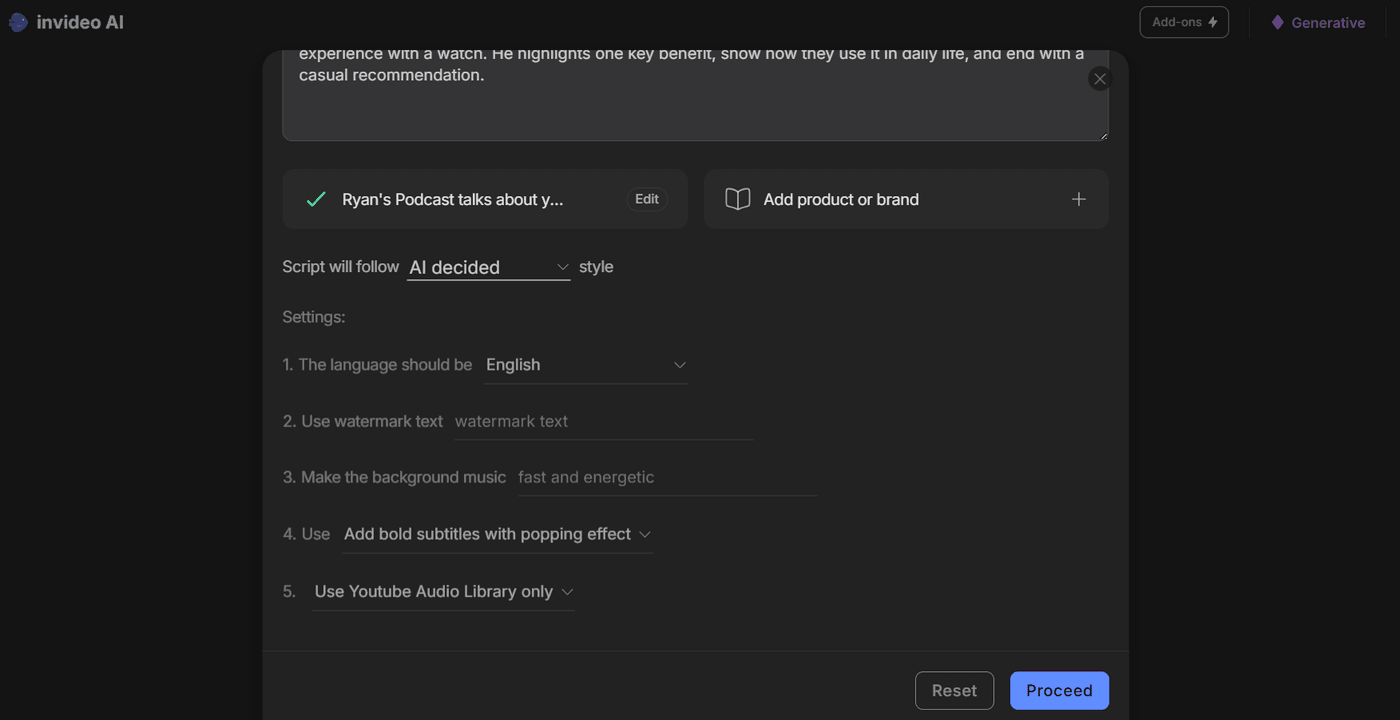
- You will now have your final prompt ready as shown below. Click on “Generate my video” to proceed.
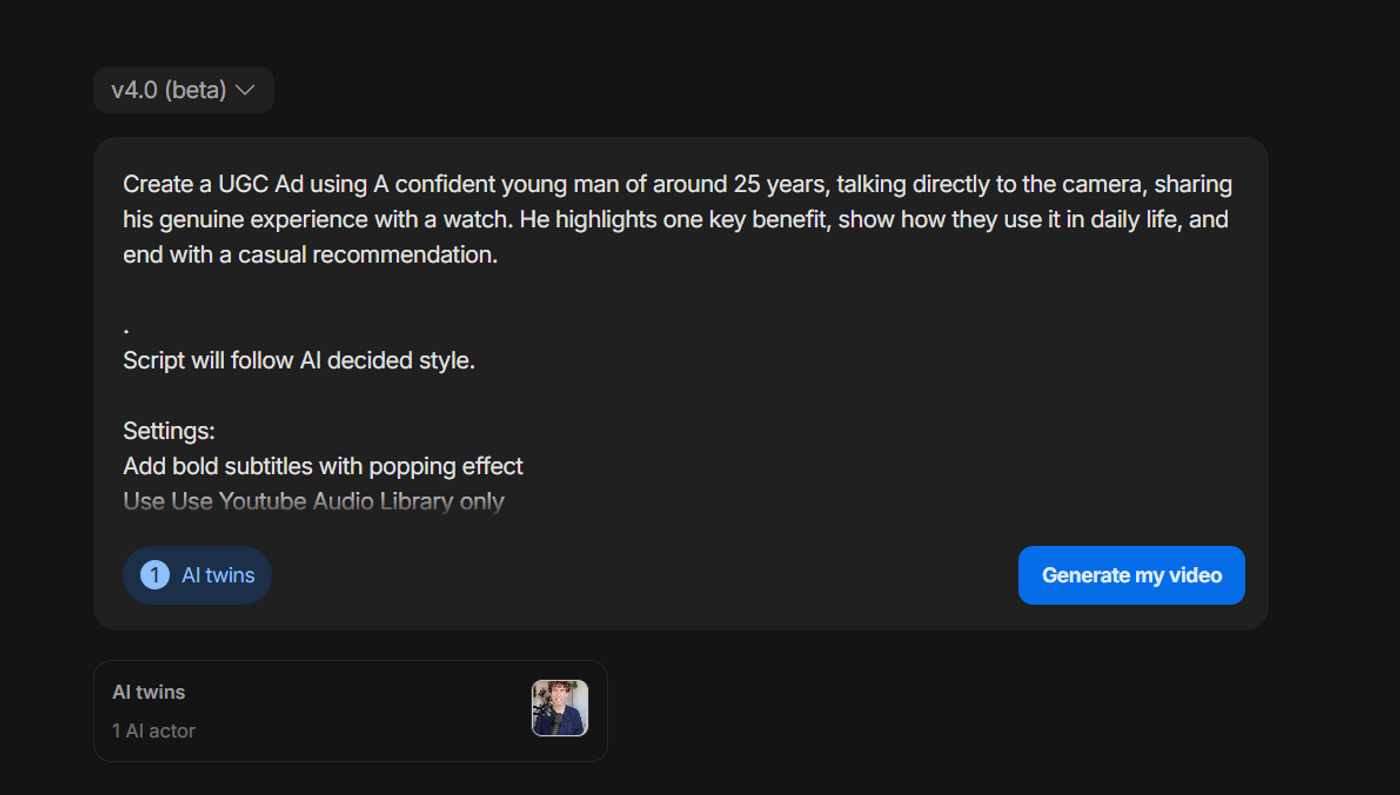
- Wait for a few minutes and let the tool process your request.
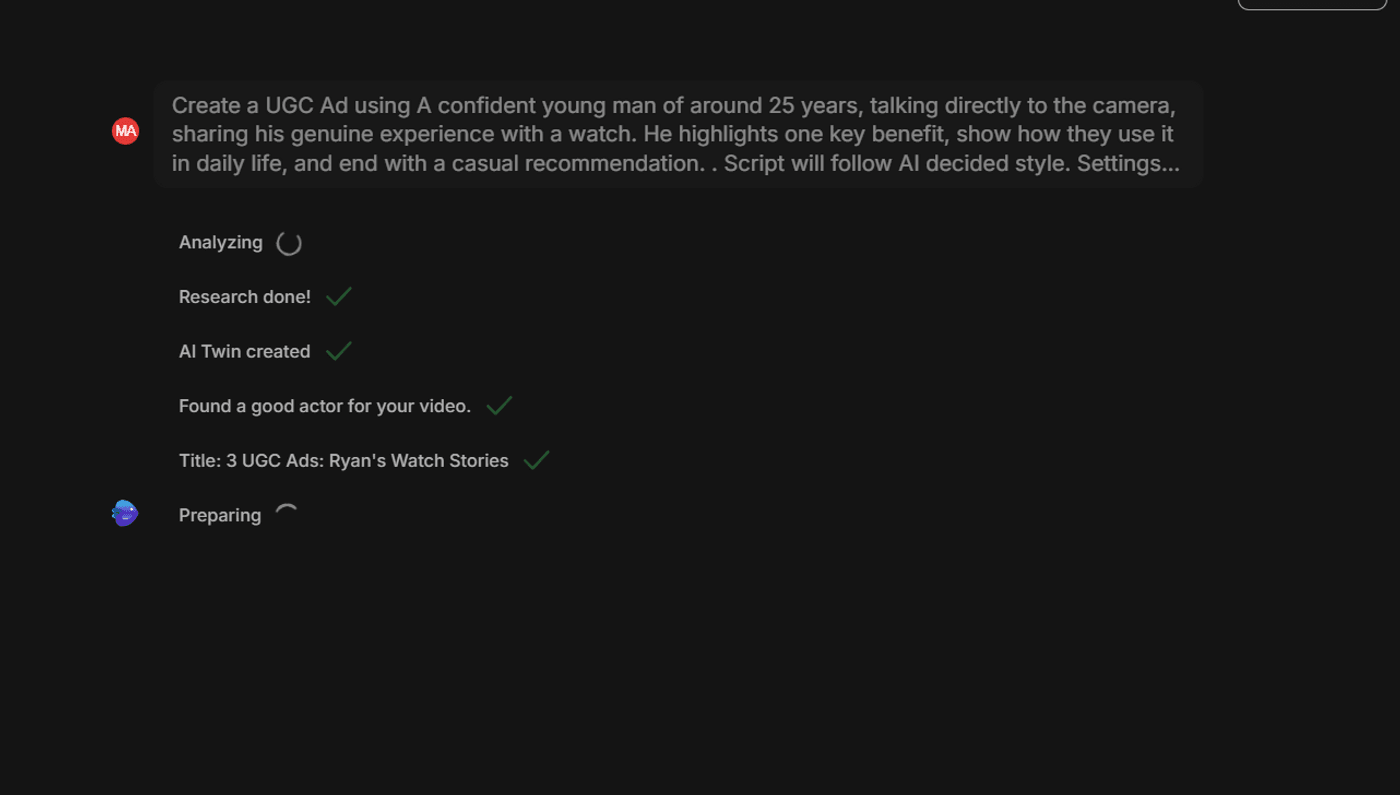
- Once the processing is done, you will see 3 options for your ad. If you want to use real human UGC actors in your video, click on “Generative UGC Ad.” Similarly, if you want to use fully AI-generated product shots in the video, click on “Generative Media Ad.” To create an ad using only stock media, click on “Stock Media Ad.”
You can also choose the number of hooks to keep in the ad. To edit your prompt, click on “Edit Prompt” to modify your input. If no changes are needed, click on “Continue” to proceed.
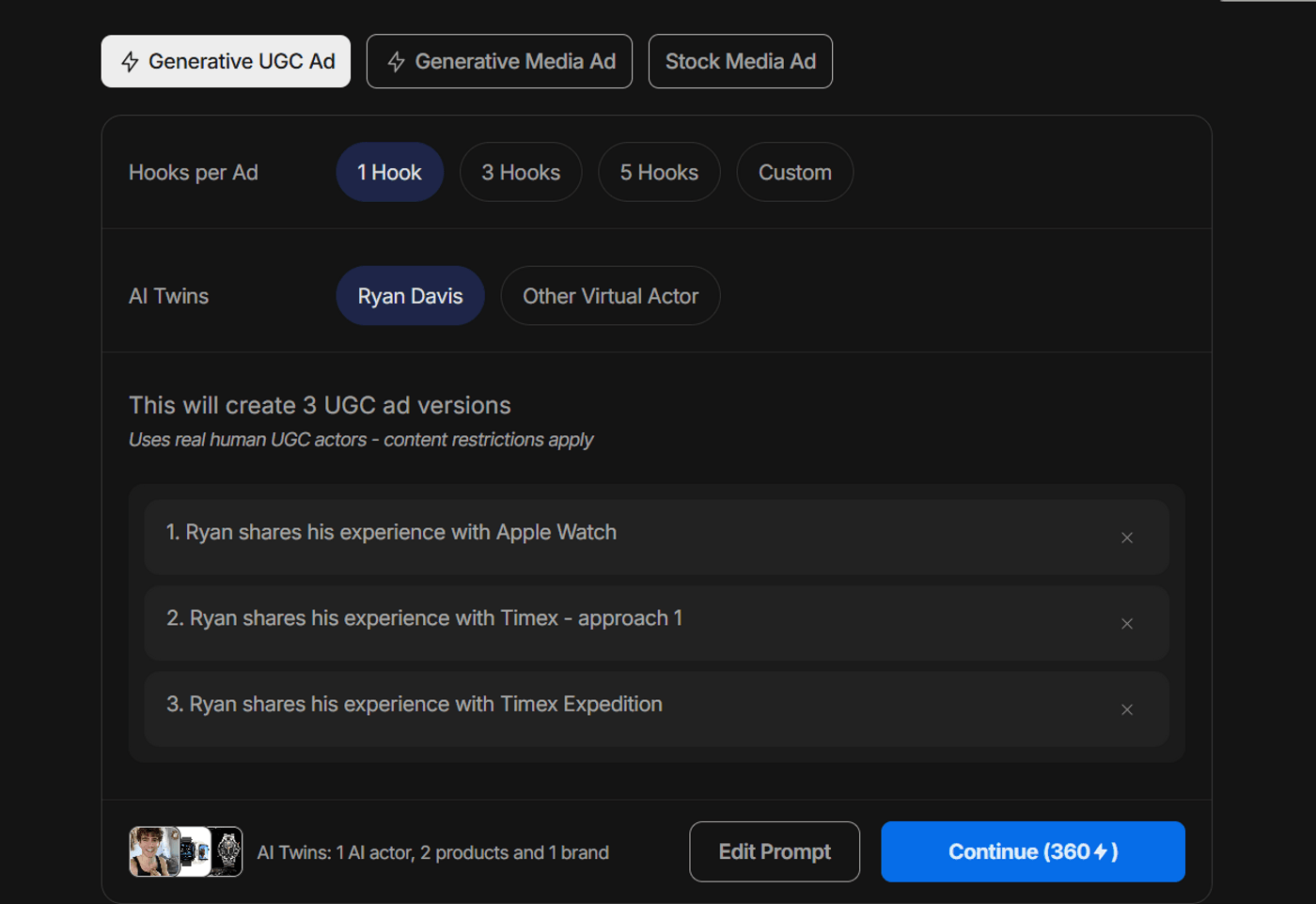
- Wait for a few seconds and let the video process.
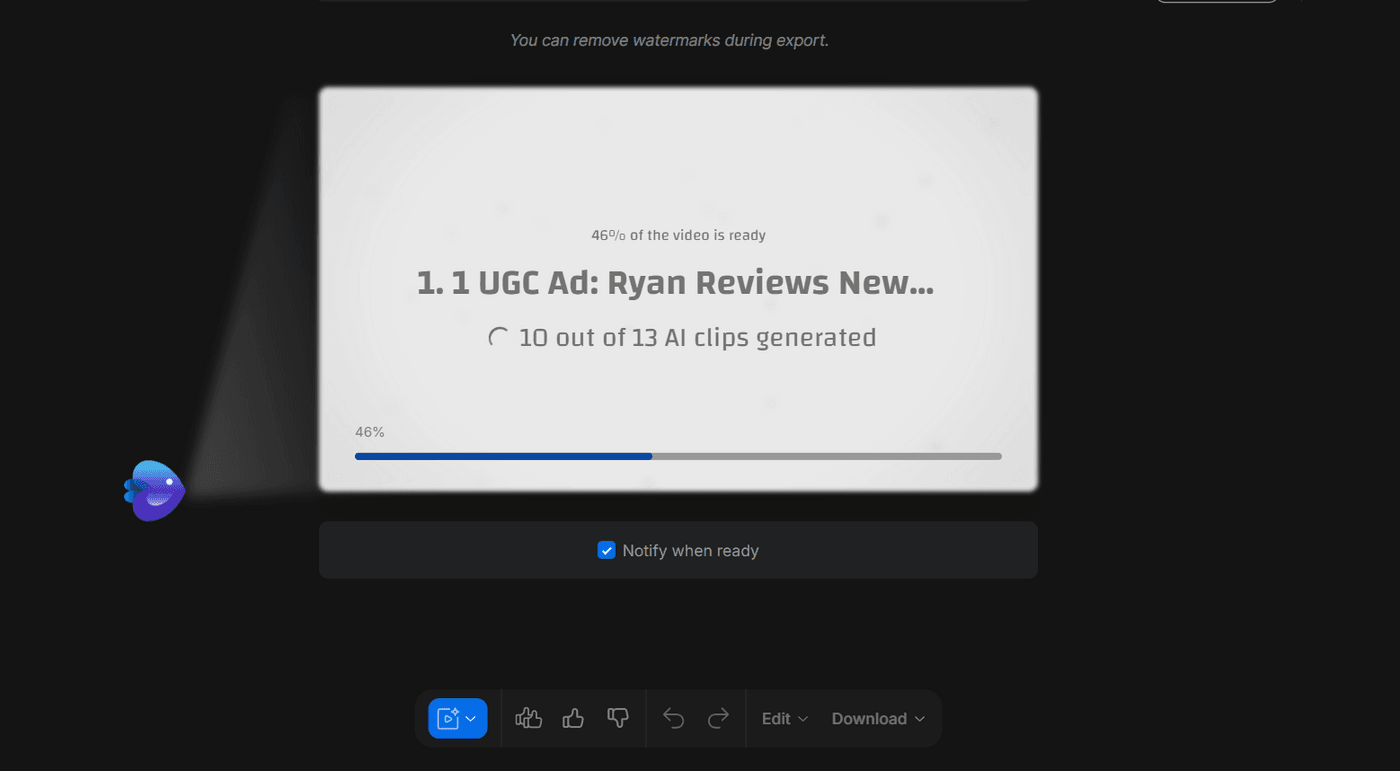
- Once your video is processed, it will be shown as below. If you want to edit anything, simply type it in the space provided. If not, click on “Download” to save the video on your device.

Challenges and Risks of AI UGC Ads
While the benefits of UGC ads are loud and clear, they do pose some tricky challenges and risks that need to be considered. Here are some points to be noted:
User Consent and Rights
Before using any kind of user-generated content, ensure you have prior consent from the original creator, even if the content feels generic or is publicly available. This is important because sometimes AI tools are trained using real user data, and mimic the real styles and personalities of people.
So, if a brand uses content without the explicit permission of the original creator, it can lead to serious legal consequences. That's why it's necessary to build strong systems around consent and privacy right from the start.
Adherence to Advertising Standards
While using AI to create user-like content, one big responsibility is being honest about what the audience is seeing. If you are using actors or AI to recreate a user's experience, it should be clear that the content isn't from a real customer. Always avoid misleading the viewers into thinking that it's an actual user review or personal story if it's not.
It's also important to be careful about what your content is claiming. If it says that the product works in a certain way or delivers a specific result, those claims need to be true and backed by real evidence. Basically, you need to be completely transparent about the content being used and shown in your AI UGC ad.
Alignment with Brand Identity
Even if you get consent and follow advertising rules, there is still a big question: Does the content truly reflect your brand?
Surely, AI can produce a wide range of content, styles, tones, and formats. But just because it looks polished or popular doesn't mean it will always fit your brand’s voice.
If the content even slightly feels off, it can confuse your audience, affect brand clarity. That’s why your content needs to be reviewed from a brand’s perspective before it goes live. This consistency is necessary because if AI-generated content sends mixed messages, it is bound to do more harm than good.
Frequently Asked Questions (FAQs)
1. What are the best tools to create AI UGC ads?
Invideo AI is one of the best tools that offer easy-to-use interfaces, pre-set templates, virtual actors, and editing options to help you create ads quickly.
2. Can I use my own script in AI UGC ads?
Yes, you can add your custom scripts, which the AI avatar or virtual human actor will deliver. This gives you control over the message while saving time and production cost even in the long-term.
3. Do AI UGC ads support different languages?
Yes, platforms like invideo AI offer multilingual support. You can create AI-generated content in various languages depending on your target market.
Make Personalized UGC Ads
Create personalized UGC ads using invideo AI with built-in scripts, hooks, and styles.
 Create now
Create now
Final Thoughts
AI UGC ads are changing how brands create and scale video content for marketing. They bring together the relatable feel of user-generated content and the efficiency of AI, which can help in producing ads that connect with audiences while saving both time and cost. That said, it’s important to approach AI UGC with thought and responsibility.
While the technology is powerful, success depends on how well you align it with your brand, follow advertising standards, and respect user rights. So, when you have the right strategy and tools in place, AI UGC ads can be a smart and scalable way to build trust and boost conversions.
Also, if you prefer learning via videos, you should check out our YouTube channel, where we share daily video creation tips and tricks, the latest video trends and ideas, and help you make more money as a video creator. That'll also help you make more money as a UGC Ads Creator.
You can also check out other recent blogs to make money as a creator:
- How to Start a YouTube Automation Channel with AI
- 32 Best Affiliate Programs With High-Income Potential
- 10 Best AI Apps Every Content Creator Should Use


